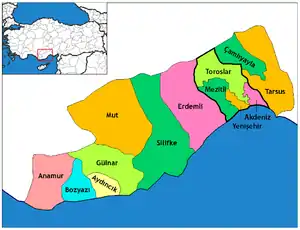Silifke
Silifke (Greek: Σελεύκεια, Seleukeia, Latin: Seleucia ad Calycadnum) is a town and district in south-central Mersin Province, Turkey, 80 km (50 mi) west of the city of Mersin, on the west end of Çukurova.
Silifke | |
|---|---|
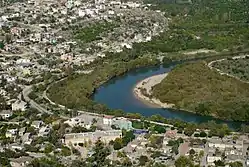 Göksu river in Silifke | |
 Silifke | |
| Coordinates: 36°22′34″N 33°55′56″E | |
| Country | |
| Province | Mersin |
| Government | |
| • Mayor | Mücahit Aktan (MHP) |
| • Kaymakam | Kemal Nazlı |
| Area | |
| • District | 2,571.84 km2 (992.99 sq mi) |
| Population (2012)[2] | |
| • Urban | 55,501 |
| • District | 114,238 |
| • District density | 44/km2 (120/sq mi) |
| Website | https://silifke.bel.tr/ |
Silifke is near the Mediterranean coast, on the banks of the Göksu River, which flows from the nearby Taurus Mountains, surrounded by attractive countryside along the river banks.
Etymology
Silifke was formerly called Seleucia on the Calycadnus — variously cited over the centuries as Seleucia [in] Cilicia, Seleucia [in,of] Isauria, Seleucia Trachea, and Seleucia Tracheotis —. The city took its name from its founder, King Seleucus I Nicator.[3] The ancient city of Olba (Turkish: Oura) was also within the boundaries of modern-day Silifke. The modern name derives from the Latin Seleucia which comes from the Greek Σελεύκεια.
History
Antiquity
Located a few miles from the mouth of the Göksu River, Seleucia was founded by Seleucus I Nicator in the early 3rd century BCE, one of several cities he named after himself. It is probable that there were already towns called Olbia (or Olba) and Hyria and that Seleucus I merely united them giving them his name. The city grew to include the nearby settlement of Holmi (in modern-day Taşucu) which had been established earlier as an Ionian colony but being on the coast was vulnerable to raiders and pirates.[4] The new city up river was doubtless seen as safer against attacks from the sea so Seleucia achieved considerable commercial prosperity as a port for this corner of Cilicia (later named Isauria), and was even a rival of Tarsus.[3]
Cilicia thrived as a province of the Romans, and Seleucia became a religious center with a renowned 2nd century Temple of Jupiter. It was also the site of a noted school of philosophy and literature, the birthplace of peripatetics Athenaeus and Xenarchus.[5] The stone bridge was built by the governor L.Octavius Memor in 77 AD. Around 300 AD Isauria was established as an independent state with Seleucia as the capital.
Christianity
Early Christian bishops held a Council of Seleucia in[6] 325, 359, and 410. Seleucia was famous for the tomb of the virgin Saint Thecla of Iconium, converted by Saint Paul, who died at Seleucia,[7] the tomb was one of the most celebrated in the Christian world and was restored several times, among others by the Emperor Zeno in the 5th century, and today the ruins of the tomb and sanctuary are called Meriamlik.[8] In the 5th century the imperial governor (comes Isauriae) in residence at Seleucia had two legions at his disposal, the Legio II Isaura and the Legio III Isaura. From this period, and perhaps later, dates the Christian necropolis, west of the town, which contains many tombs of Christian soldiers.[9] According to the Notitia Episcopatuum of the Patriarchate of Antioch, in the 6th century, the Metropolitan of Seleucia had twenty-four suffragan sees.[10]
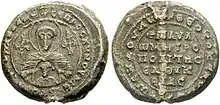
In 705 Seleucia was captured by the Arab armies of Islam and was recovered by the Byzantines. Thus by 732 nearly all the ecclesiastical province of Isauria was incorporated into the Patriarchate of Constantinople; henceforth the province figures in the Notitiae of the Patriarchate of Constantinople, but under the name of Pamphylia.
In the Notitiae of Leo VI the Wise (ca. 900) Seleucia had 22 suffragan bishoprics;[11] in that of Constantine Porphyrogenitus (ca 940) it had 23.[12] In 968 Antioch again fell into the power of the Byzantines, and with the Province of Isauria, Seleucia was allocated to the Patriarchate of Antioch.[13] We know of several metropolitans of this see, the first of whom, Agapetus, attended the Council of Nicaea in 325; Neonas was at the Council of Seleucia in 359; Symposius at the Council of Constantinople in 381; Dexianus at the Council of Ephesus in 431; Basil, a celebrated orator and writer, whose conduct was rather ambiguous at the Second Council of Ephesus and at the beginning of the Council of Chalcedon in 451; Theodore was at the Fifth Ecumenical Council in 553; Macrobius at the Sixth Ecumenical Council and the Council in Trullo in 692.
No longer a residential see, Seleucia in Isauria has been included in the list of titular sees of the Catholic Church, which has made no new appointments of a titular bishop to this eastern see since the Second Vatican Council.[14]
Turkish period
In the 11th century, the city was captured by the Seljuk Turks; they met with resistance and in 1137, Seleucia was besieged by Leon of Cilician Armenia. During this period of struggle between Armenians, Byzantines, Crusaders, and Turks, a stronghold was built on the heights overlooking the city. On June 10, 1190, the Emperor Frederick Barbarossa was drowned trying to cross the Calycadnus,[3] near Seleucia during the Third Crusade.
In the 13th century Seleucia was in the possession of the Hospitallers, who lost it to the Karamanid Principality in the second half of the 13th century, and then it ended up in the hands of the Ottomans under general Gedik Ahmet Pasha in 1471.
Until 1933, Silifke was the capital of İçel Province, but then, İçel and Mersin provinces were merged. The merged province took the name of İçel but with its administrative centre at Mersin. Finally in 2002 the name of İçel was replaced with that of Mersin.
Economy
The economy of the district depends on agriculture, tourism and raising livestock. The town of Silifke is as a market for the coastal plain, which produces beans, peanuts, sesame, banana, orange, lemon, cotton, grapes, lentils, olives, tobacco, and canned fruits and vegetables. An irrigation project located at Silifke supplies the fertile Göksu delta. In recent years there has been a large investment in glasshouses for producing strawberries and other fruit and vegetables in the winter season.
Silifke is also an industrial town, well-connected with other urban areas and producing beverages, chemicals, clothes, footwear, glass, plastics, pottery, and textiles.
Climate
Silifke has a hot-summer Mediterranean climate (Köppen climate classification Csa) with hot and dry summers and mild and wet winters.
| Climate data for Silifke | |||||||||||||
|---|---|---|---|---|---|---|---|---|---|---|---|---|---|
| Month | Jan | Feb | Mar | Apr | May | Jun | Jul | Aug | Sep | Oct | Nov | Dec | Year |
| Average high °C (°F) | 14 (57) |
15 (59) |
18 (64) |
23 (73) |
26 (79) |
30 (86) |
32 (90) |
33 (91) |
31 (88) |
27 (81) |
23 (73) |
16 (61) |
24 (75) |
| Average low °C (°F) | 6 (43) |
7 (45) |
8 (46) |
12 (54) |
15 (59) |
19 (66) |
21 (70) |
22 (72) |
20 (68) |
16 (61) |
13 (55) |
8 (46) |
14 (57) |
| Average precipitation mm (inches) | 170 (6.7) |
70 (2.8) |
50 (2.0) |
60 (2.4) |
30 (1.2) |
0 (0) |
0 (0) |
0 (0) |
0 (0) |
10 (0.4) |
70 (2.8) |
170 (6.7) |
630 (25) |
| Average rainy days | 9 | 5 | 4 | 4 | 2 | 0 | 0 | 0 | 0 | 1 | 4 | 9 | 38 |
| Average relative humidity (%) | 62 | 65 | 62 | 62 | 67 | 65 | 67 | 66 | 58 | 55 | 61 | 65 | 63 |
| Source: Weatherbase[15] | |||||||||||||
Administrative structure
Towns
Villages
- Ayaştürkmenli
- Bahçe
- Bahçederesi
- Balandız
- Bayındır
- Bolacalıkoyuncu
- Burunucu
- Bükdeğirmeni
- Canbazlı
- Cılbayır
- Demircili
- Ekşiler
- Evkafçiftliği
- Gedikpınarı
- Gökbelen
- Gülümpaşalı
- Gündüzler
- Hüseyinler
- Hırmanlı
- Işıklı
- Karahacılı
- Karakaya
- Kargıcak
- Kavak
- Keben
- Kepez
- Keşlitürkmenli
- Kocaoluk
- Kocapınar
- Kurtuluş
- Kıca
- Kırtıl
- Kızılgeçit
- Mağara
- Nasrullah
- Nuru
- Ortaören
- Ovacık
- Pelitpınarı
- Sabak
- Sarıaydın
- Senir
- Seydili
- Seyranlık
- Sökün
- Sömek
- Tosmurlu
- Türkmenuşağı
- Ulugöz
- Uşakpınarı
- Yenibahçe
- Yenisu
- Yeğenli
- Çadırlı
- Çaltıbozkır
- Çamlıbel
- Çamlıca
- Çatak
- Çeltikçi
- Ören
- Özboynuinceli
- Öztürkmenli
- İmambekirli
- İmamlı
- İmamuşağı
- Şahmurlu
Main sights
- The caves of "Heaven and Hell" ('Cennet ve Cehennem'), which have collapsed in two places revealing deep holes in the ground.
- Narlıkuyu is an attractive village, where people from Mersin come to eat fish and enjoy the seaside.
- The town of Silifke has many well preserved ancient ruins including:
- The prominent remains of the castle high on a rock above the town,
- The city walls,
- A large water tank (Tekir ambarı) cut into the rock,
- An extensive necropolis of rock-cut tombs with inscriptions.
 Outer walls of the castle of Silifke
Outer walls of the castle of Silifke Silifke castle
Silifke castle Bar next to the castle of Silifke
Bar next to the castle of Silifke Touristic panel describing the castle of Silifke
Touristic panel describing the castle of Silifke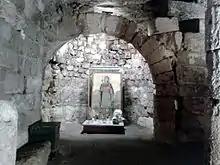
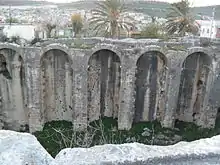 Tekir ambarı cistern
Tekir ambarı cistern
Life and culture
The Turkmen community of Silifke has a strong tradition of folk music and dance including songs such as The Yogurt of Silifke (where the dancers imitate the actions of making yogurt) and another one where they wave wooden spoons about as they dance.
The cuisine includes breakfast of leaves of unleavened bread (bazlama) with a dry sour cottage cheese (çökelek) or fried meats. Many other dishes feature bulgur wheat. The annual Silifke Yoghurt Festival takes place in May.
See also
- Other Seleucias
- Acacius of Caesarea
- Assyrian Church of the East
- Aya Tekla Church
- Council of Rimini
- Cyprus Memorial Cemetery in Silifke
- Çukurova
- Dana Adası
- Eudoxius of Antioch
- Işıkkale
- Karakabaklı
- Gökkale
- Meydankale
- Narlıkuyu
- Seleucid Empire
- Silifke Museum
- Sinekkale
- Uzuncaburç
- Silifke Castle
- Silifke Göksu Anadolu Lisesi
References
- "Area of regions (including lakes), km²". Regional Statistics Database. Turkish Statistical Institute. 2002. Retrieved 2013-03-05.
- "Population of province/district centers and towns/villages by districts - 2012". Address Based Population Registration System (ABPRS) Database. Turkish Statistical Institute. Retrieved 2013-02-27.
- Chisholm, Hugh, ed. (1911). . Encyclopædia Britannica. 24 (11th ed.). Cambridge University Press. p. 603.
- Stephanus of Byzantium; Strabo, XIV, 670)
- Classical Gazetteer, page 312
- (variously cited)
- Acta Pauli et Theclae, an apocryphal work of the 2nd century
- (Denkschriften der k. Akadem. der Wissenschaft. philos.-histor. Klasse, Vienna, XLIV, 6, 105-08)
- Edwards, Robert W., "Seleukeia (Cilicia)" (2016). The Eerdmans Encyclopedia of Early Christian Art and Archaeology, ed., Paul Corby Finney. Grand Rapids, Michigan: William B. Eerdmans Publishing. p. 491. ISBN 978-0-8028-9017-7.
- (Echoes d'Orient, X, 145)
- Heinrich Gelzer, Ungedruckte . . . Texte der Notitiae episcopatuum, 557.
- (Georgii Cyprii descriptio orbis romani, ed. Gelzer, 76)
- (Gelzer, op. cit., 573)
- Annuario Pontificio 2013 (Libreria Editrice Vaticana, 2013, ISBN 978-88-209-9070-1), p. 968
- http://www.weatherbase.com/weather/weatherall.php3?s=3371&refer=&units=metric&cityname=Silifke-Turkey
 This article incorporates text from a publication now in the public domain: Herbermann, Charles, ed. (1913). "Seleucia Trachea". Catholic Encyclopedia. New York: Robert Appleton Company.
This article incorporates text from a publication now in the public domain: Herbermann, Charles, ed. (1913). "Seleucia Trachea". Catholic Encyclopedia. New York: Robert Appleton Company.
External links
| Wikimedia Commons has media related to Silifke. |
